
Monument - Jeṭhā Gaṇeśh Mandira || जेठा/ज्याठा गणेश मन्दिर
MONUMENT
NEPAL HERITAGE DOCUMENTATION PROJECT (NHDP)
8/31/2023
Name
Monument name: Jeṭhā Gaṇeśh Mandira
Alternative name(s): Jyāthā Gaṇeśh Mandira
Anglicized name: Jetha Ganesh Mandir (1646 CE)
Name in Devanagari: जेठा गणेश मन्दिर
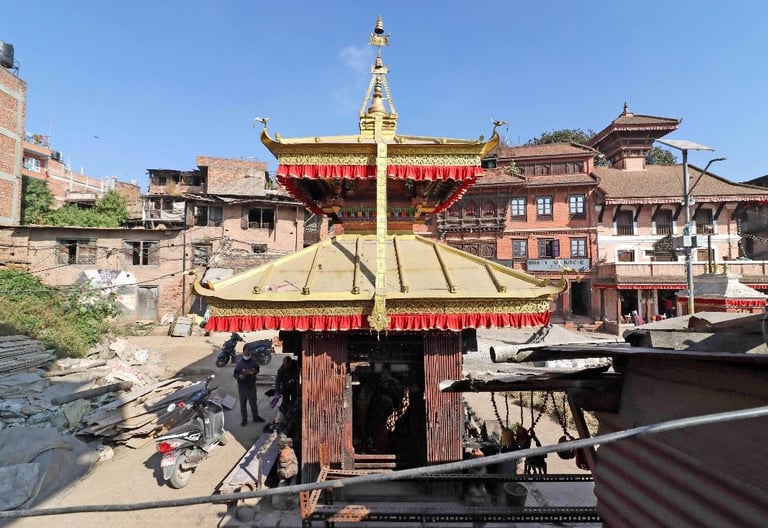

LOCATION
Province number: Bagamati Province
District: Bhaktapur
Municipality / village council: Bhaktapur Municipality
Heritage focus area: Pottery Suqare Area
Local area name: Talako Tole (Pottery Suqare कुम्हः त्व)
Jeṭhā Gaṇeśh Mandira, view from S; photo by Yogesh Budathoki; 2021-11-13
Description (English)
Jeṭhā Gaṇeśh Mandira is a two-tiered temple at the Tālākva Ṭola. It is ituated on a densely populated square of members of the Prajāpati caste (a potter caste known as kumhāḥ in Newari). The Jeṭhā Gaṇeśh Temple was constructed and the finial with a chatra was installed in 1646 CE (NS 766) when Mādhavasiṃha Prajāpati from the Ghaṭakhā Ṭola was the thakāli of the area. It is said that the temple was previously called Jyāthā Gaṇeśh. The Prajāpatis of Tālākva Ṭola worship Jeṭhā Gaṇeśh as Viśvakarmā, the deity of skills. Since ducks are the vehicle (vāhāna) of Viśvakarmā, the Prajāpatis of Tālākva do not consume duck meat (Mānandhara 2051, p. 14). They are known for their skilled pottery of black clay and they also make clay pots required for the worship of Taleju.
The Jeṭhā Gaṇeśh Temple faces south with sheets of gilt copper laid on its roofs. A finial in the shape of a kalaśa under a chatra tops the roof. The first floor of the temple contains struts with carvings of Aṣṭa-Bhairavas, the group of eight Bhairavas. The ground floor, on the other hand, has struts carved with the figures of the Aṣṭamātṛkās (Eight Mother Goddesses). A brass statue of Gaṇeśh is enshrined in the sanctum as the main deity. The original statue was stolen and was replaced by a new one with donations collected from the local community. The statue of Gaṇeśh receives a hood of seven nāgas and four toraṇas. The northern wall of the Temple has a painting of Gaṇeśh. There is a hole on the ground known as yaḥsĩgāḥ in front of the temple. It is the pit where a yaḥsĩ is erected during the Biskāḥ Jātra in Bhaktapur. A stone laid amid the brick-paved ground to the west of the temple is assigned for potters to make Aliṃdyaḥ while the ihī ceremony is performed.
Description (Nepali)
भक्तपुरको तालाक्व टोलमा कुम्हाले (प्रजापति) हरूको बाहुल्यता रहेको छ । परम्परागत कामको आधारमा तालाक्व टोलमा बस्ने कुम्हालेहरूले कालो माटोबाट भाँडाकुँडा बनाउँछन् । तलेजुको पूजाआजाको लागि चाहिने माटाका भाँडाकुँडा पनि उनीहरूले नै बनाउँछन् । त्यस टोलमा जेठा गणेशको दक्षिणाभिमुख मन्दिर रहेको छ । कुम्हालेहरू बसोबास गर्ने क्षेत्रमा बनाइएको हुनाले यस मन्दिरलाई ज्याथा गणेश मन्दिर भनिएको हो । पछि ध्वनि परिवर्तन भएर जेठा गणेश मन्दिर भनिएको हो । तालाक्व टोलका प्रजापतिहरू यी गणेशलाई सीपका देवता अर्थात् विश्वकर्मा मानी पूजा गर्छन् र विश्वकर्माको वाहन हाँस भएकोले उनीहरू हाँसको मासु खाँदैनन् (Mānandhara 2051, p. 14) । मन्दिरमा दुई तहको तामाको छाना राखिएको छ । छानामा सुनको मोलम्बा लगाइएको छ । छानामा कलशाकारको सुवर्ण गजूर राखी छत्र ओढाइएको छ । मन्दिरको पहिलो तलामा अष्टभैरव अङ्कित टुँडाल राखिएका छन् भने भुइँतलामा अष्टमातृका अङ्कित टुँडाल राखिएका छन् । गर्भगृहभित्र ढलोटको गणेश स्थापना गरिएको छ । पुरानो मूर्ति चोरी भएपछि स्थानीयहरूले चन्दा उठाएर नयाँ मूर्ति स्थापना गरेका थिए । गणेशलाई सातवटा नागले ओढाई चार तहको तोरण चढाइएको छ । मन्दिरको उत्तरी भित्तामा गणेशको चित्र लेखिएको छ । मन्दिर अगाडि यःसिँ ठड्याउने खाल्डो (यःसिँगाः) र पश्चिममा इहीको लागि अलिंद्यःको प्रतिमा बनाउने ढुङ्गा रहेको छ ।
यो मन्दिर नेसं ७६६ (सन् १६४६) मा घटखा टोलमा बस्ने पजापति (प्रजापति) माधवसिंह टोलको प्रमुख (थकाली) हुँदा गणेशको मन्दिर निर्माण गरी गजूर र छत्र चढाइएको थियो । विसं २०७७ (सन् २०२०) मा टोलबासीहरूसँग चन्दा उठाएर झिङ्गटीको छाना झिकी सुनको मोलम्बा लगाइएको तामाको छाना हालिएको थियो ।
तालाक्व टोलका प्रजापतिहरूद्वारा जेठा गणेश मन्दिर सञ्चलान गर्न गणेद्यः गुठी गठन गरिएको छ । त्यस गुठीमा आवद्ध गुठीयारहरूले पालो मिलाएर बिहान मन्दिरको ढोका खोलेर नित्यपूजा चलाइरहेका छन् । बिस्केट जात्राको क्रममा प्रत्येक वर्ष चैत्र मसान्तको दिनमा मन्दिर अगाडि यःसिँ ठड्याइन्छ र वैशाख ५ गते ढालिन्छ । यःसिँ ठड्याउने गुठी सञ्चालनका लागि मल्लकालमा हाकुदेव प्रजापति (सत्यराम प्रजापति) भन्ने एक जना कुम्हालेले जग्गा गुठी राखिदिएका थिए । त्यसै गुठीको आयस्ताले यो जात्रा वर्षैपिच्छे चल्दै आइरहेको छ । गुठी संस्थानको लगतमा जेठा गणेशको यःसिँ गुठीको नाममा ५ रोपनी र पर्वपूजा गर्न १० रोपनी जग्गा रहेको देखिन्छ (Guṭhī Saṃsthāna 2071, p. 90) । स्थानीयका अनुसार अहिलेसम्म सरकारको तर्फबाट कुनै आर्थिक सहयोग प्राप्त भएको छैन । प्रत्येक वर्ष बिस्केट जात्राको क्रममा वैशाख २ गते द्यःछेँमा राखिएको गणेशको ढलोटको मूर्तिलाई खटमा राखेर जात्रा गरिन्छ । भक्तपुरका नेवार कन्याको इही गर्दा यस मन्दिरको पश्चिममा रहेको ढुङ्गामा माटोको अलिंद्यः बनाएर प्राण प्रतिष्ठा गरिन्छ । भोलिपल्ट इहीको दिनमा सोही अलिंद्यःको प्रतिमालाई विवाह मण्डपमा ल्याएर कन्याहरूले पूजा गर्नुपर्ने परम्परा छ ।
The procession of Jeṭhā Gaṇeśh takes place every year during the Biskāḥ Jātrā. On the 27th solar day of Caitra, the statue of Jeṭhā Gaṇeśh enshrined at his dyaḥchẽ at the Tālākva Ṭola is dethroned from his seat for the preparation of the procession. On the 2nd solar day of Vaiśākha, the brass statue is carried on a palanquin and taken around various localities like the Ghaṭakhā Ṭola and Bolāchẽ Ṭola etc. accompanied by traditional Newari orchestra. The palanquin is then brought back to the Tālākva Ṭola and is rested for some time. The palanquin of Jeṭhā Gaṇeśh is then collided with another palanquin of Bulucā Bhailaḥdyaḥ (Baṭuka Bhairava) that is brought from the Bolāchẽ Ṭola. The statue of Jeṭhā Gaṇeśh is ascended back to his seat at the dyaḥchẽ on the 5th solar day of Vaiśākha marking the completion of the procession.
Every year during the Biskāḥ Jātrā, a 40-cubit (hāta) long yaḥsĩ is erected at the yaḥsĩgāḥ in the morning of the last day of Caitra. The yaḥsĩ also known as Lhāḥ Madu Yaḥsĩdyaḥ, the pole deity without [stretched out] hands, is toppled down on the 5th solar day of Vaiśākha, the last day of the Biskāḥ Jātrā. According to a legend, Yaḥsĩdyaḥ had stolen lumps of meat of a buffalo sacrificed to Bhairava whose chariot is taken around in Bhaktapur during the Biskāḥ Jātrā. Bhairava then cut off his hands as a punishment. Therefore, the yaḥsĩ erected in front of the Jeṭhā Gaṇeśh Temple does not have a horizontal bar at the top that represents the stretching arms of Yaḥsĩdyaḥ. The Prajāpatis of the Tālākva Ṭola erect the yaḥsĩ. They also have a guthi named Jeṭhā Gaṇeśh Yaḥsĩ Guthi for erecting it. A potter named Hākudeva Prajāpati (also known Satyarāma Prajāpati) had donated some plots of land to form the Yaḥsĩ Guthi during the Malla period. The income of this Guthi is still used for the erection of the yaḥsĩ.
Event, Social and Religious activities
The Prajāpatis of the Tālākva Ṭola have formed a Gaṇeśh Guṭhī for the operation of the Jeṭhā Gaṇeśh Mandira. The members of the Guṭhī take a turn to perform the daily rituals at the Temple.
Erecting yaḥsĩ (ल्याेः सी ठानेगु)
Daily worship (nityapūjā)
Chariot procession (khaṭajātrā)
Moulding Aliṃdyaḥ for ihī (इही जगे याता– चा फ्ञः वैगु)
A plain stone laid (BKT0510-006) on the ground west of the Jeṭhā Gaṇeśh Mandira plays an important role during the ihī ceremony of Newar girls of Bhaktapur. About two weeks ahead of the ihī ceremony, a kisalī is offered to the thakāli of the Prajāpatis of Tālākva. One day before the ihī ceremony, the thakāli sculpts a clay figure of Aliṃdyaḥ on this stone. Although the clay figure looks like a śivaliṅga, he is a clay deity of ambiguous identity. He is mostly referred to as Anantaliṅgeśvara, but some call him Agni (the fire deity) as well (Gutschow and Michaels 2008, p. 130). As the clay figure is given three eyes for the ritual, he is also worshipped as Tryambakeśvara Mahādeva. The figure of Aliṃdyaḥ is brought to the site of the ihī ceremony the next day and the girls who undergo the ritual worship him.
Initial construction
The Temple was constructed and the finial with a chatra was installed in 1646 CE (NS 766) when Mādhavasiṃha Prajāpati from the Ghaṭakhā Ṭola was the thakāli of the area.

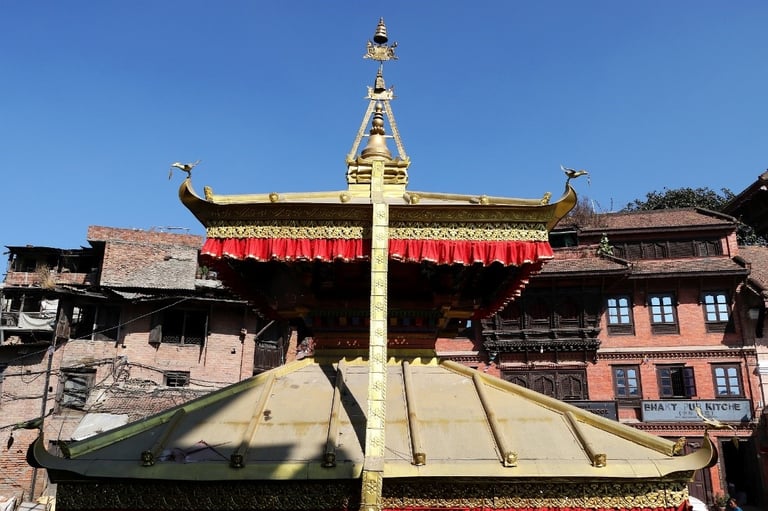

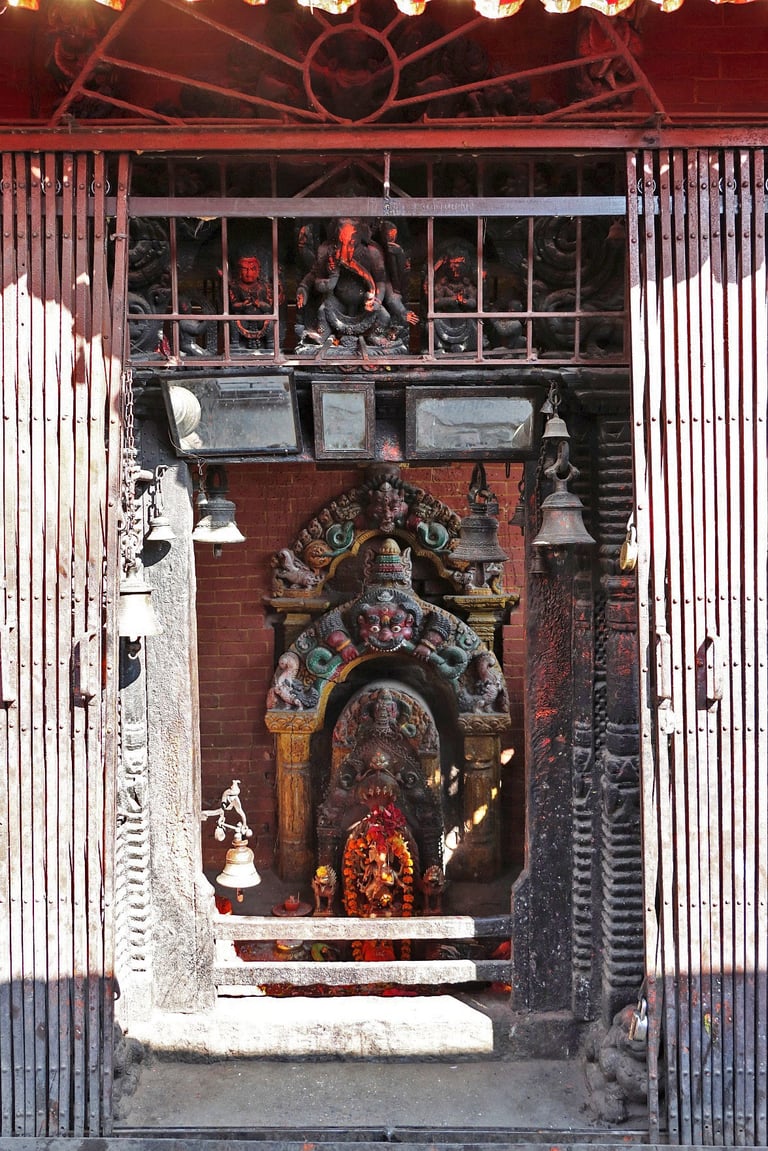

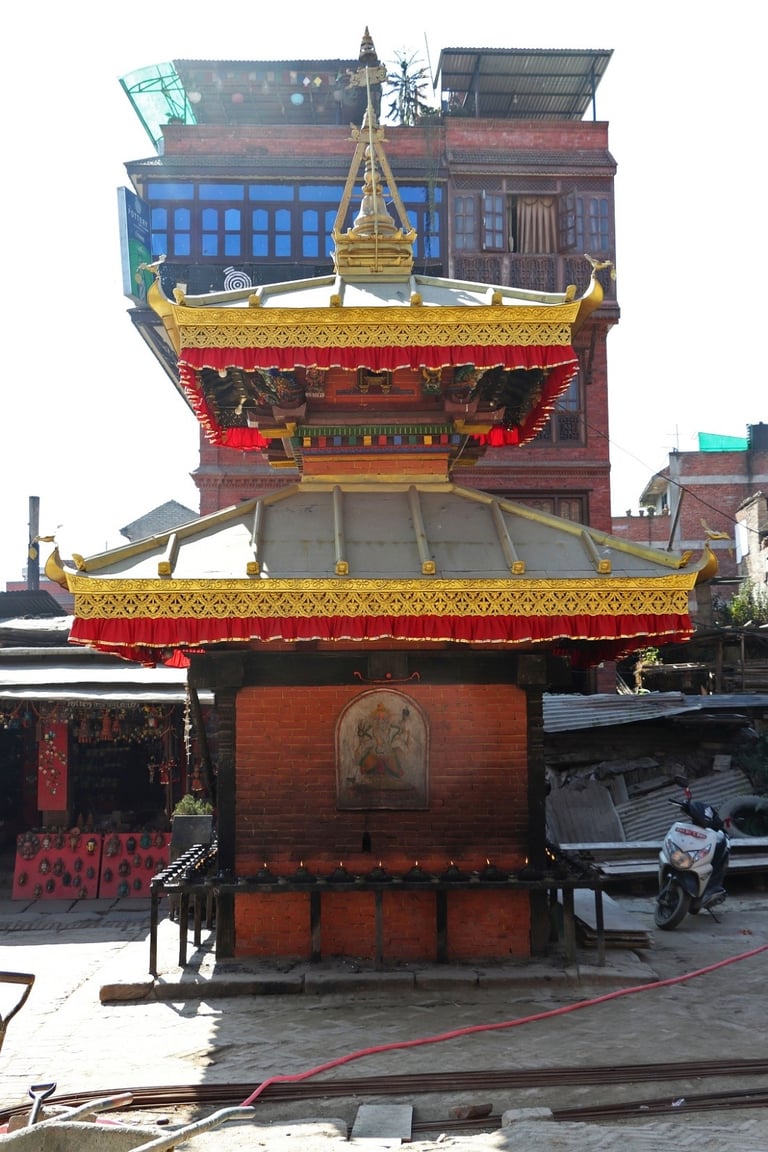
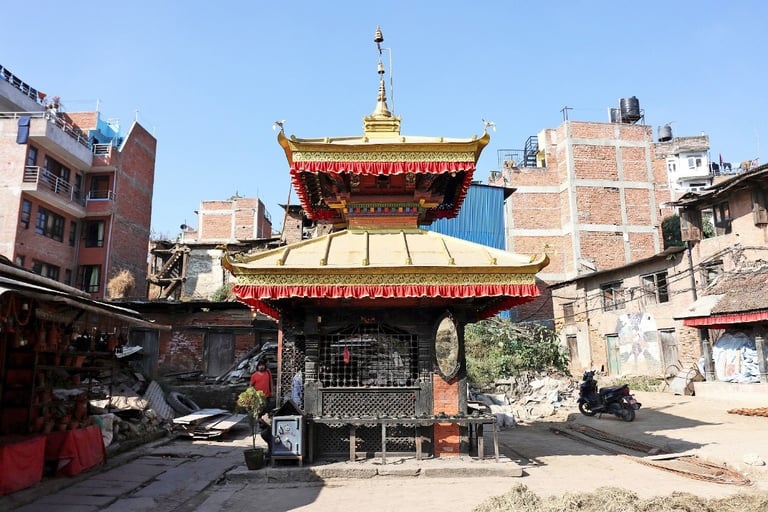
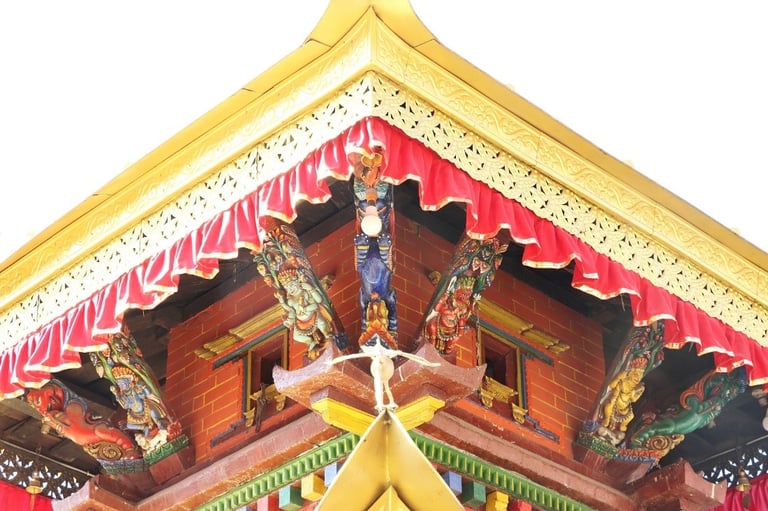
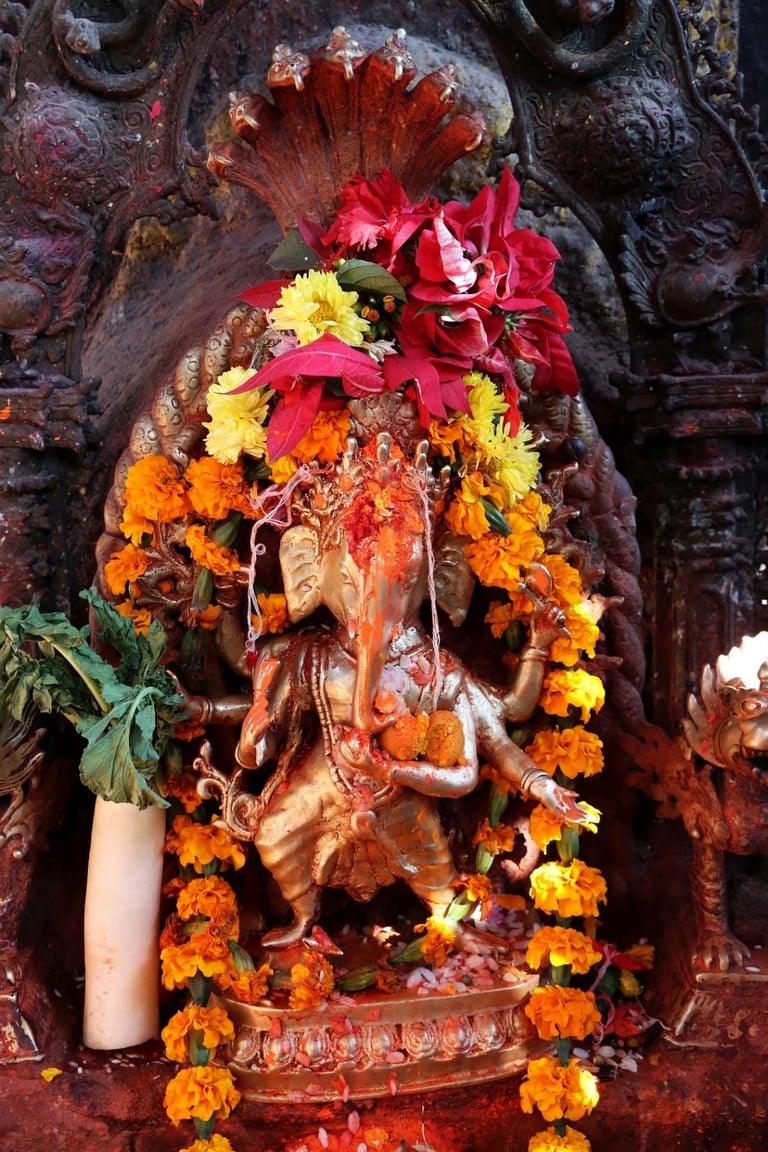
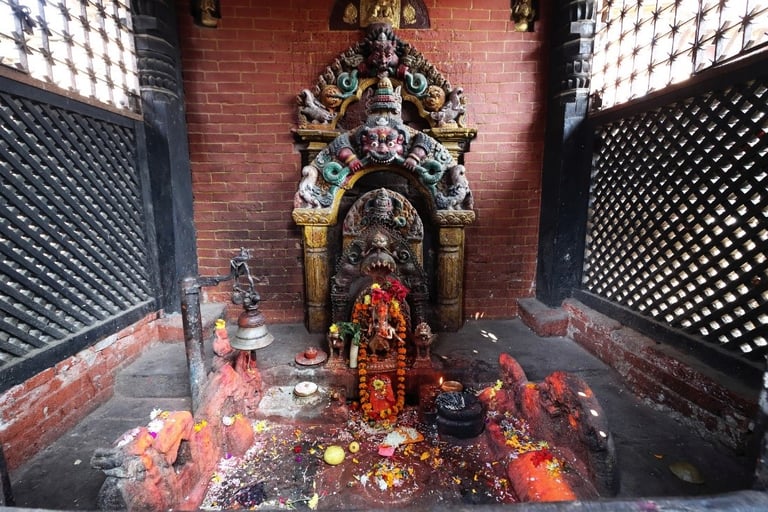
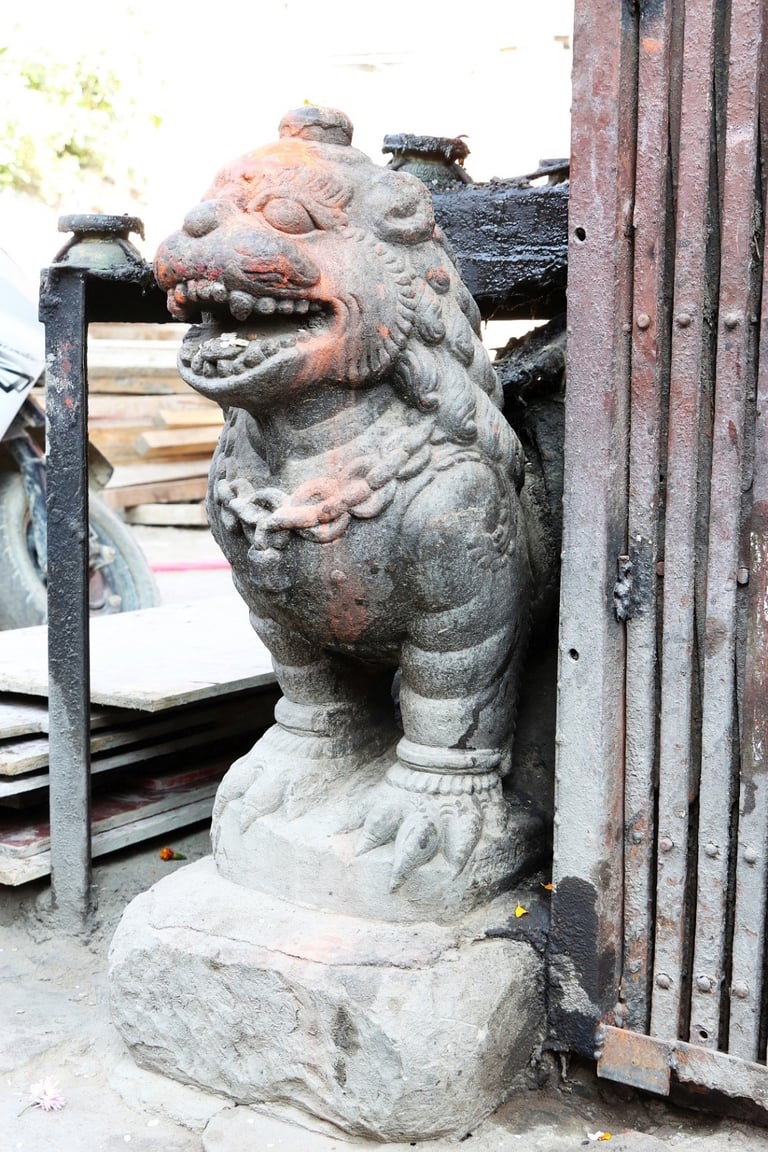

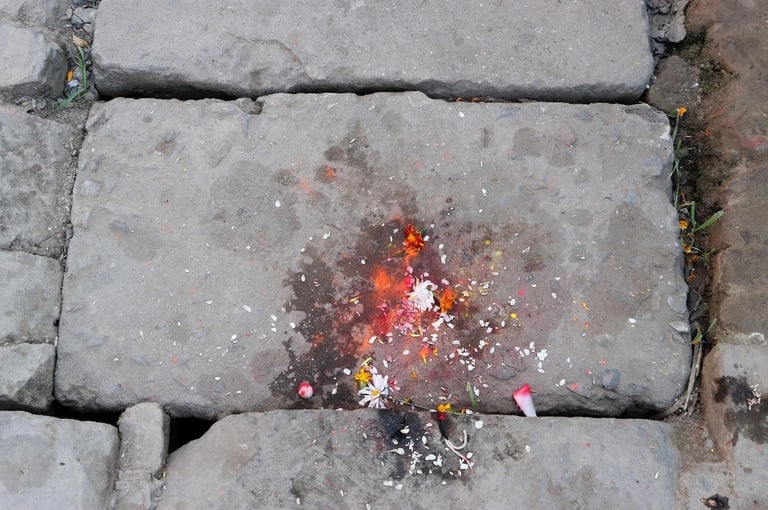
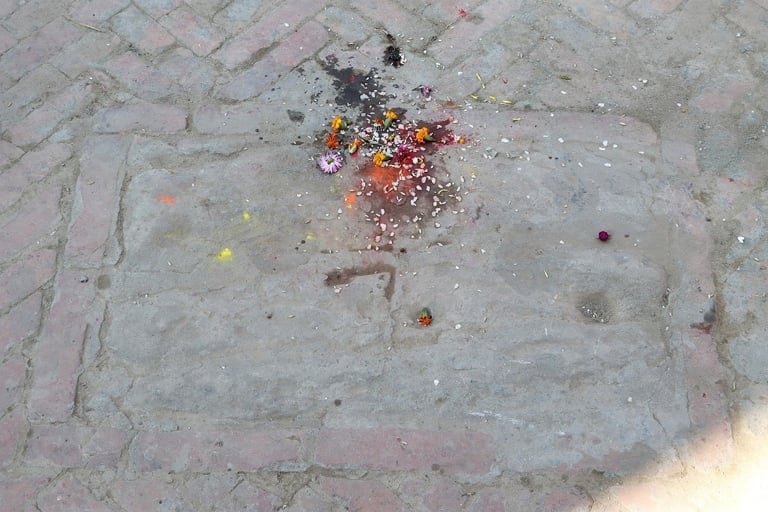




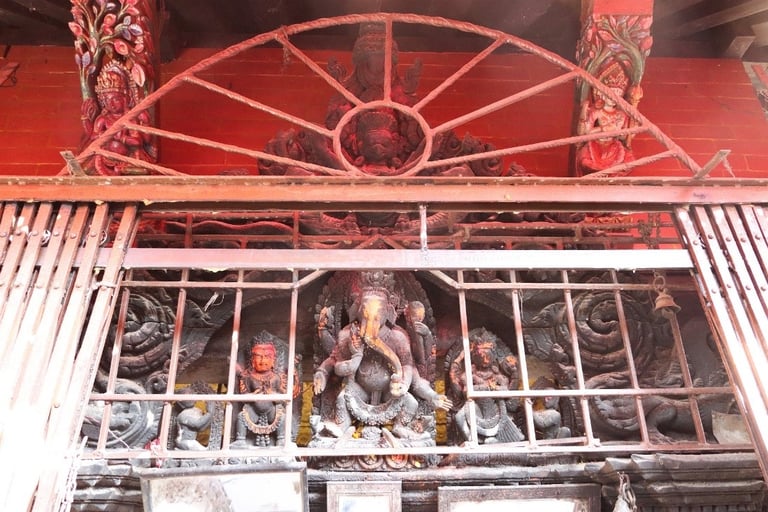
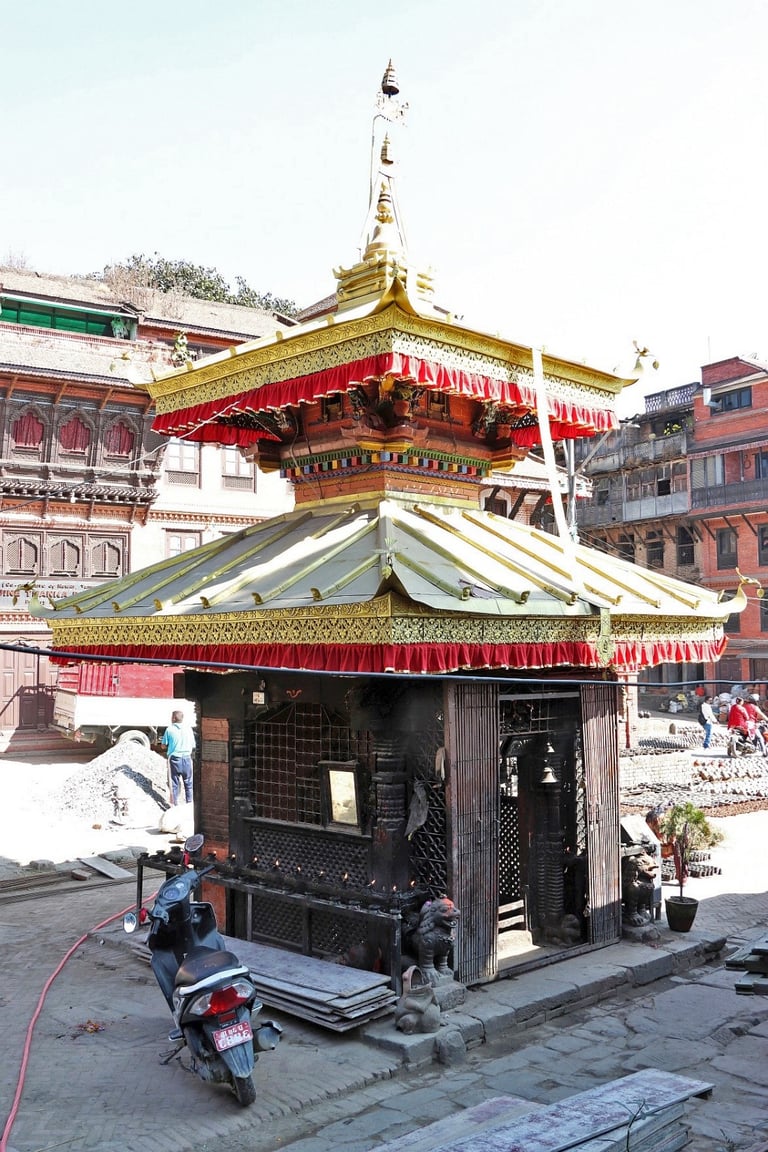
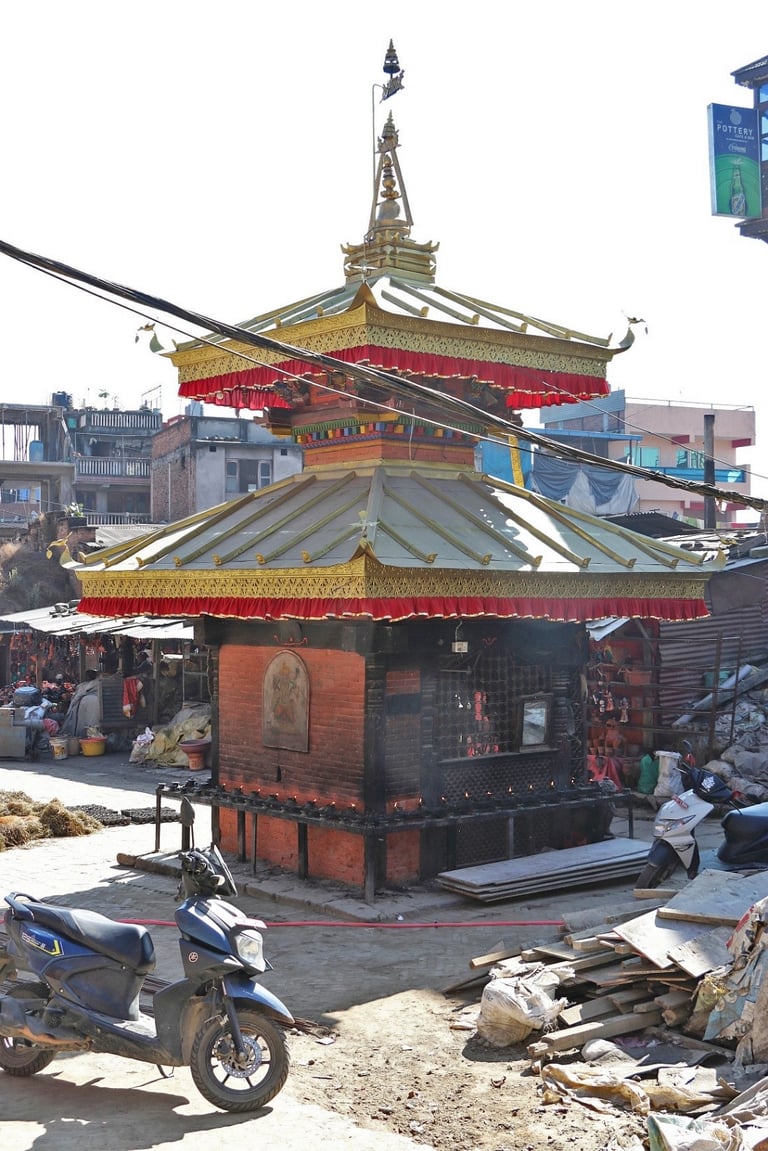
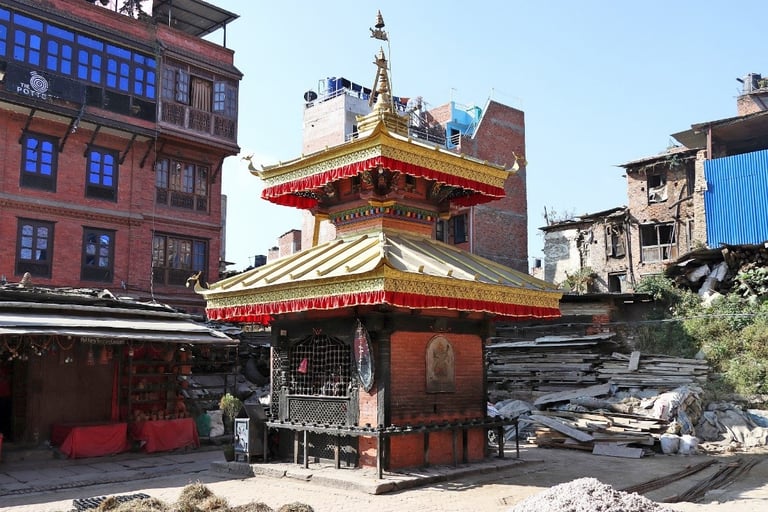
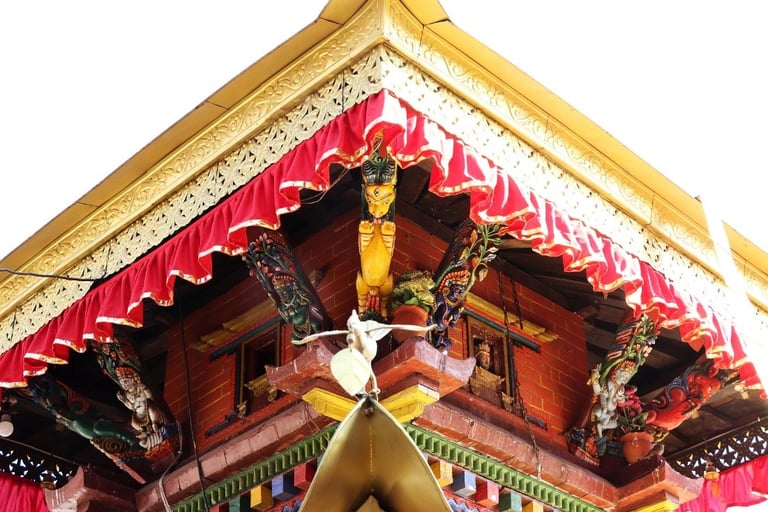

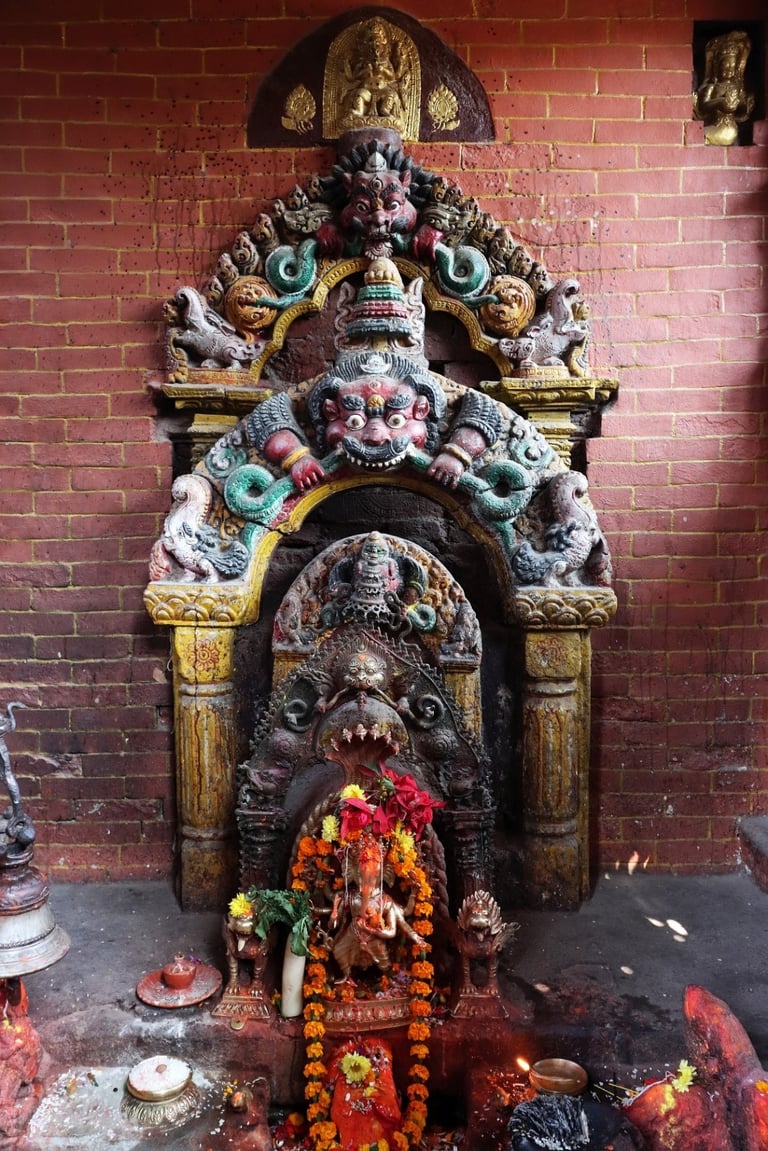

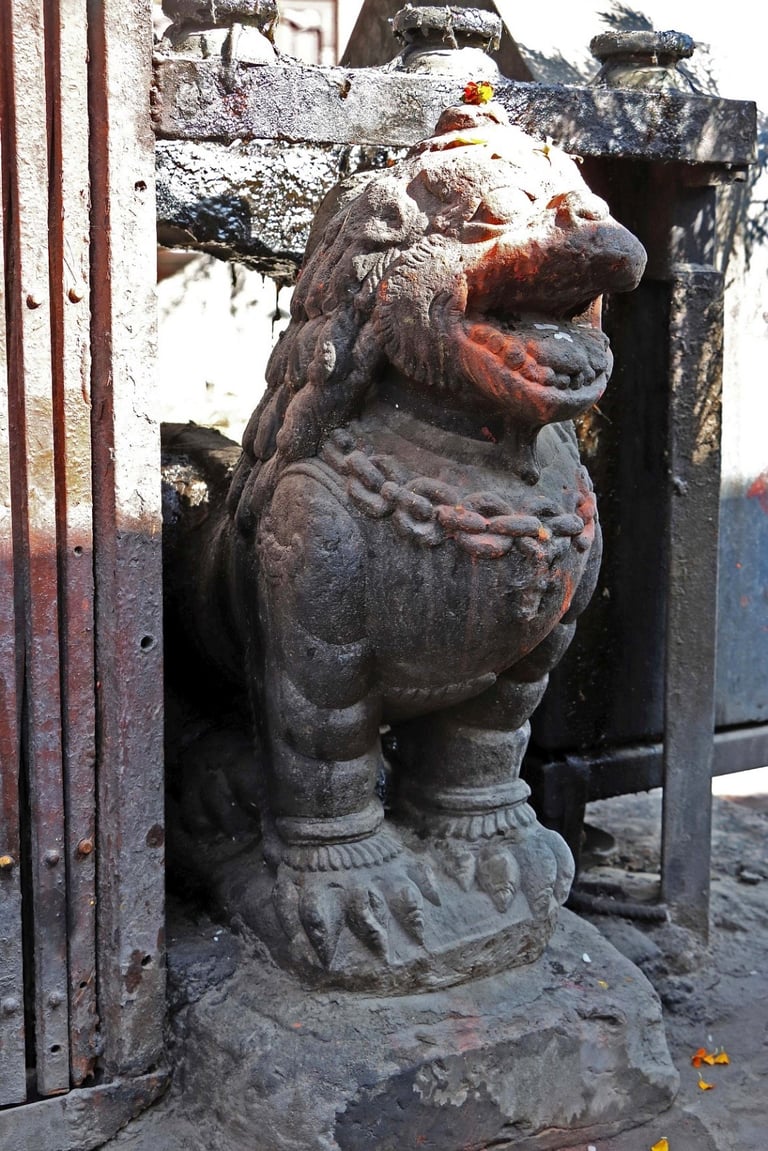

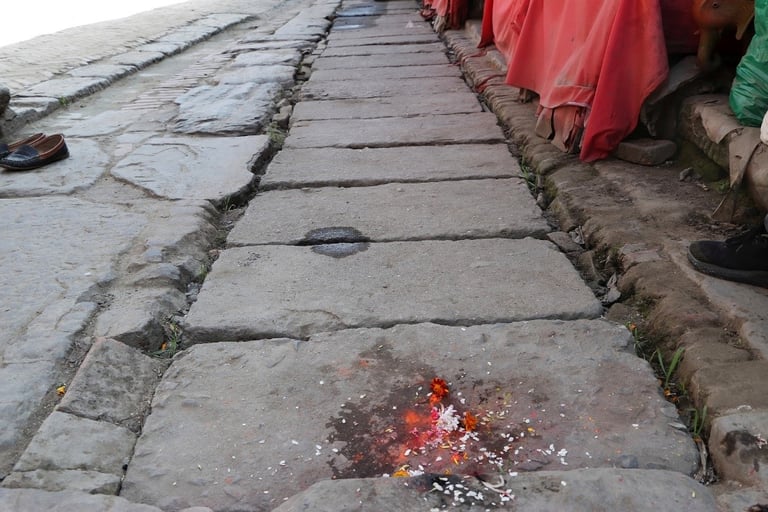
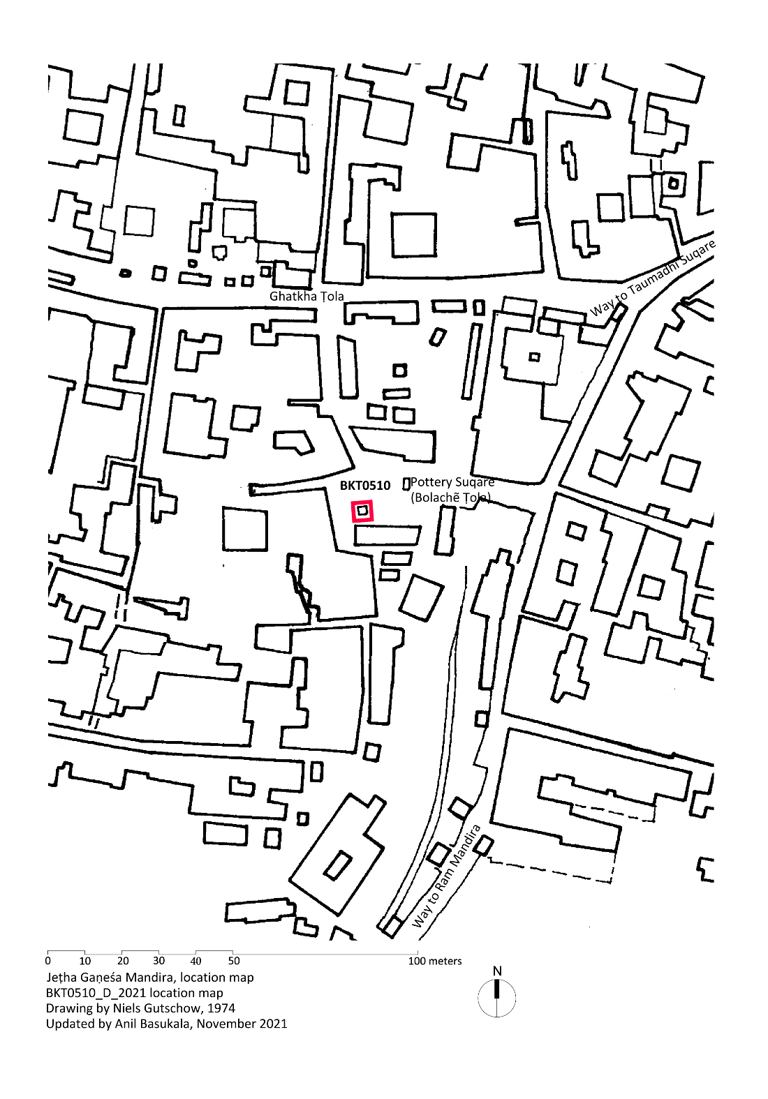
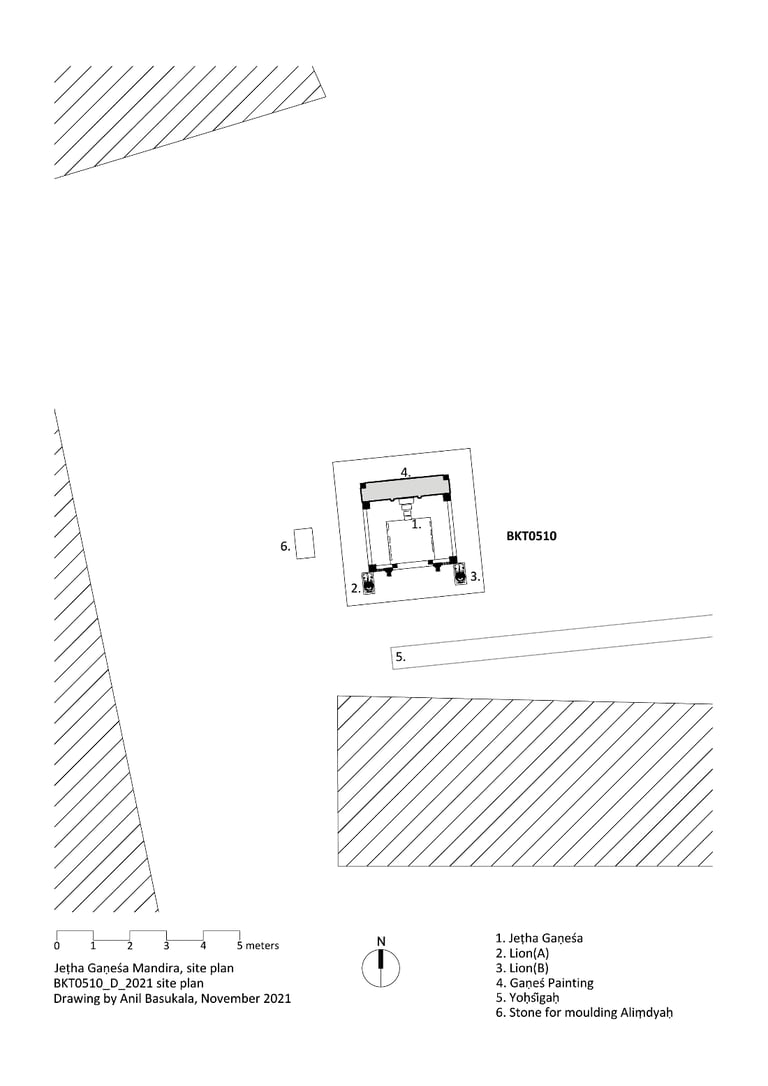































Jeṭhā Gaṇeśh Mandira, close-up view, from S; photo by Yogesh Budathoki; 2021-11-13
Painting of Jetha Ganesh at Back Wall of the Temple
Jeṭhā Gaṇeśh Mandira, Pinnacle, view from S; photo by Yogesh Budathoki; 2021-11-13
Jeṭhā Gaṇeśh Mandira, toraṇa above the entrance, view from S; photo by Yogesh Budathoki; 2021-11-13
Jeṭhā Gaṇeśh Mandira, upper part of the Mandira, view from S; photo by Yogesh Budathoki; 2021-11-13
Jeṭhā Gaṇeśh Mandira, lower view with entrance, view from S; photo by Yogesh Budathoki; 2021-11-13
Jeṭhā Gaṇeśh Mandira, view from SW; photo by Yogesh Budathoki; 2021-11-13
Jeṭhā Gaṇeśh Mandira, close-up view of the entrance, from S; photo by Yogesh Budathoki; 2021-11-13
Jeṭhā Gaṇeśh Mandira, view from W; photo by Yogesh Budathoki; 2021-11-13
Jeṭhā Gaṇeśh Mandira, view from NW; photo by Yogesh Budathoki; 2021-11-13
Jeṭhā Gaṇeśh Mandira, view from NE; photo by Yogesh Budathoki; 2021-11-13
Jeṭhā Gaṇeśh Mandira, struts on the upper part of the Mandira, view from SW; photo by Yogesh Budathoki; 2021-11-13
Jeṭhā Gaṇeśh Mandira, view from N; photo by Yogesh Budathoki; 2021-11-13
Jeṭhā Gaṇeśh Mandira, view from S; photo by Carl Pruscha; 1973–1974; courtesy of Carl Pruscha; free access – no reuse; source: Carl Pruscha, Kathmandu Valley, 1975, vol. II, p. 231 (B-51)
Jeṭhā Gaṇeśh Mandira, view from E; photo by Yogesh Budathoki; 2021-11-13
Jeṭhā Gaṇeśh Mandira, struts on the upper part of the Mandira, view from NE; photo by Yogesh Budathoki; 2021-11-13
Jeṭhā Gaṇeśh Mandira, statue of Gaṇeśh with the toraṇa above in the sanctum, view from S; photo by Yogesh Budathoki; 2021-11-13
Jeṭhā Gaṇeśh Mandira, statue of the lion (A) at the western side of the entrance, view from SW; photo by Yogesh Budathoki; 2021-11-13
Jeṭhā Gaṇeśh Mandira, statue of Gaṇeśh in the sanctum, view from S; photo by Yogesh Budathoki; 2021-11-13
Jeṭhā Gaṇeśh Mandira, wide view of the sanctum with Gaṇeśh, view from S; photo by Yogesh Budathoki; 2021-11-13
Jeṭhā Gaṇeśh Mandira, statue of the lion (A) at the western side of the entrance, view from SE; photo by Yogesh Budathoki; 2021-11-13
Jeṭhā Gaṇeśh Mandira, statue of the lion (B) at the eastern side of the entrance, view from SW; photo by Yogesh Budathoki; 2021-11-13
Jeṭhā Gaṇeśh Mandira, painting of Gaṇeśh on the north wall of the Mandira, view from N; photo by Yogesh Budathoki; 2021-11-13
Jeṭhā Gaṇeśh Mandira, statue of the lion (B) at the eastern side of the entrance, view from SE; photo by Yogesh Budathoki; 2021-11-13
Jeṭhā Gaṇeśh Mandira, wide view of the Yaḥsĩgāḥ (covered by the slab) in front of the entrance, view from W; photo by Yogesh Budathoki; 2021-11-13
Jeṭhā Gaṇeśh Mandira, Yaḥsĩgāḥ (covered by the slab) in front of the entrance, view from W; photo by Yogesh Budathoki; 2021-11-13
Jeṭhā Gaṇeśh Mandira, stone for moulding Aliṃdyah at the western side of the Mandira, view from E; photo by Yogesh Budathoki; 2021-11-13
Jeṭhā Gaṇeśh Mandira; location map by Niels Gutschow; 1974; updated by Anil Basukala, 2021-11-10
Jeṭhā Gaṇeśh Mandira; floor plan by Bijay Basukala; 2021-11-18
Jeṭhā Gaṇeśh Mandira; site plan by Anil Basukala; 2021-11-18
Jeṭhā Gaṇeśh Mandira, stone inscription attached on the western wall of the Mandira from NS 766, view from W; photo by Yogesh Budathoki; 2021-11-13
Trainings
Bolachhen, Talako Tole
Bhaktapur Municipality Ward No 4
Bagmati Province, Nepal
©2025 potterysquare.com All right reserved. Development platform: Hostinger Builder.
